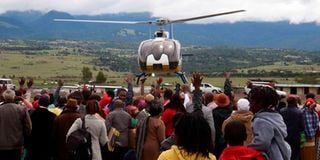KCAA warns politicians on use of helicopters during campaigns

Makutano residents wave as the helicopter carrying Deputy President William Ruto after a fundraiser at Makutano trading area on November 23, 2019.
The Kenya Civil Aviation Authority (KCAA) has raised an alarm over the use of helicopters as politicians intensify their campaigns ahead of the August 9 General Election.
KCAA director-general Gilbert Kibe said the authority has organised a meeting with helicopter owners and operators to remind them of safety concerns and regulations.
He cautioned that unchecked increase in the use of aircrafts poses danger to users, operators and the public.
While the use of helicopters is considered safe and fast, any slight mistake can be disastrous to humans and property, said Mr Kibe.
“We will have a meeting with stakeholders, including helicopter operators, security personnel and owners to enlighten them on the need to observe aviation regulations,” he said on Friday.
Among other safety regulations, the KCAA boss, who spoke during a media breakfast in Kisumu, pointed out that the operators need to be cautious on where they land and take off.
“A minimum radius of 30 metres from where it lands or takes off should be maintained. No person or object should be within this area,” he added.
Accidents
He noted that curiosity of members of the public could lead to accidents in cases where the main rotor blades and rotor tails come in contact with any object.
He further raised concerns over incidents of bird strikes at Jomo Kenyatta International Airport (JKIA), Kisumu International Airport and Wajir airport.
“JKIA reports 22 bird strikes every month, followed by Wajir (12) while Kisumu has 3 to 6 bird strikes every month,” he said.
Other than the birds getting killed, the planes can get badly dented and destroy the engines,” he said.
He thanked Kisumu County Government for relocating their dumpsite from around their airport, a move that has seen reduced birds in the flight path.
While indicating that they were investing in bird deterrent systems, Mr Kibe added that they are closely working with Kenya Airports Authority and the Kenya Wildlife Services to curb the menace which threatens the aviation industry.
Meanwhile, the DG has called on owners and operators of Unmanned Aircraft Systems (UAS) also known as drones to be registered as a means of ensuring safety.
He said that most of the gadgets were being flown without operation licences.
Drones
According to the new regulations, owners are supposed to pay Sh3,000 and a further Sh2,000 before engaging in any operation.
“Despite having thousands of drones in the country, only 200 drones and a similar number of pilots are registered to operate on our skies.
“KCAA anticipates increased usage of drones within the Western region especially for data collection and research for environmental conservation around the lake basin and other natural resources such forests, survey and mapping as well as academic research,” said Mr Kibe.
The DG noted that drones are increasingly becoming part of business in provision of other services including health care emergency services, creative economy, filming industry, sports and news gathering.





